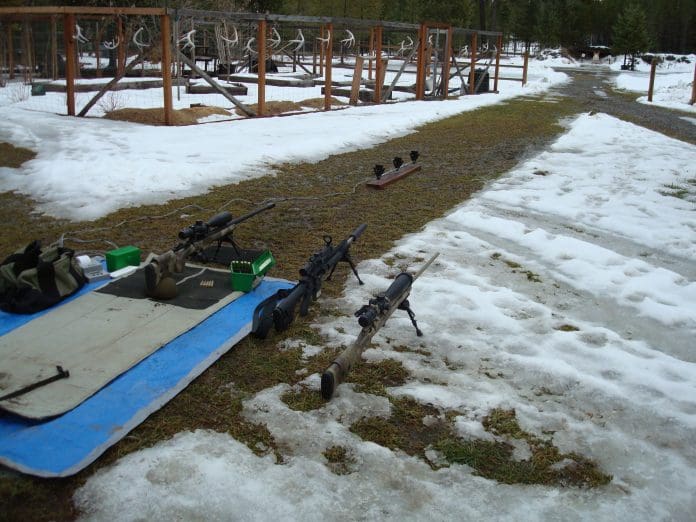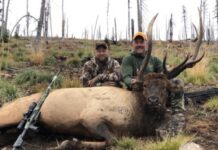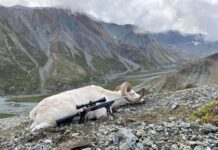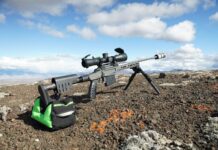Rehearsing the Long Range Shot
Sam Millard
My friend, Shawn Carlock, once told me, “You should have so much confidence in your ability to make the shot, that you are genuinely surprised if you miss!” I took that advice to heart and shape my long range shooting practice around it.
Like all of the long range shooters I know, I am a gun nut. I spend all year hand loading ammo and shooting. When the snow is blowing sideways, I spend hours in the basement dry-firing at tack heads to perfect my trigger press. As soon as it stops blowing, I plow a lane with the tractor and make some noise on the 100 yard lane. I test my rifles, the ammunition, and myself every chance I get in the off season. For the last several years, I have stayed away from the bench and shoot from the prone position for all load testing and zero checks. I always have at least one rifle in the truck while out in the woods in case a good long range target presents itself, usually in the form of a cluster of rocks across a canyon. My kids are well conditioned to sharing cab space with a drag bag or two!
Polishing our marksmanship skills and testing our rifles are important steps on the road to a successful shot, but I don’t consider them practice for making a precision shot on a critter at distance. I like to practice for long range hunting by “rehearsing” the most likely shots I will get.
Living and hunting in northern Idaho, I am blessed with excellent hunting and shooting opportunities. In 2012, I drew a buck tag that allows rifle hunting for any buck from August 30 to the end of November. My passion is for whitetail hunting, but this tag was clearly designed for a high country mule deer hunt. I had never hunted mule deer before, but have seen plenty of fuzzy antlered bucks during fall bear season. I picked a drainage I used to bear hunt in and started scouting it with my kids. While I was scouting, I was taking notes on shooting distances, elevation, sun position, barometric pressures, etc. I used this info to build drop charts for likely shots in case my ballistic computer called in sick while on the mountain. I settled on a canyon area that offered shots from 700-1500 yards. Because of the distances I could shoot, I decided my Defensive Edge Canyon rifle in +P 338 Edge would get the nod.
I started packing in the rifle and all of my gear into this canyon several weeks before opening day. I picked the east side of the canyon to capitalize on a first light shot (I am usually a last light shooter, but the drainage has the highest density of grizzlies in Idaho when the berries ripen. When killing cross-canyon, you have to consider recovery that might not even start for an hour or more even with a perfect shot!) I sketched out range cards and started shooting. Small rocks turned into scapulas, bigger rocks became lung areas. Every shot was taken as if it was on a buck…no group shooting here! When I practice, I usually won’t bother taking a shot if I can’t pick out a target that forces me to hold 1 MOA or less to score a hit at whatever distance I’m shooting at. I found the morning and evening thermals, the mid-morning wind, the late afternoon gusts, and shot through them all. By the time opening day arrived, I had fired 68 shots and filled out 9 pages of sketches and notes! Most of those shots were taken at benches, grassy swales, and ridgelines where I had observed velvety bucks hanging out. Speaking of the bucks, you are probably thinking I’m crazy for making all this noise right where I want to hunt! I don’t worry about it. The animals don’t care! I shot at rocks that were within 100 yards or so from bedded or feeding bucks several times. Those bucks also became dry fire targets. It was excellent practice for learning when to break the shot! I felt I had done all I could to prepare for the shot. I had essentially rehearsed the shot as closely to the real thing as I could.
I sat out opening day waiting for my long time friend and hunting partner, Mark, to show up to act as spotter. The drainage seemed to fill up with other hunters overnight! I didn’t worry because I had a plan. Mark and I hiked in the second day exactly as I had done so many times before while scouting. We stopped at one of the benches I had chosen as a likely shooting position and started glassing. Within 10 minutes, I caught a buck moving along an alder patch above a small bench. Mark has hunted mule deer, so I asked him to check the buck out. He told me he was a shooter! I set up on the buck and positioned Mark behind me on the spotter. The range was 852 yards. I dialed 17.00 up and settled in to gauge the wind. I called no wind, but knew from shooting here before that a light thermal would be flowing from my right until the sun fully broke the ridge behind me. I dialed ½ minute right. I told Mark to put his plugs in and keep his eye on the buck. The buck started moving in and out of the alder, causing Mark to get very agitated! “We’re losing him! I think we lost him!”I knew from watching these bucks that he would present me with a shot eventually and he did.
As he stretched out broadside, I told Mark to keep an eye on him. The trigger broke cleanly and the recoil punched straight back, allowing me to call a hit. The buck stumbled up the ridge a few yards and rolled back onto the bench where he began, the 300 grain SMK doing its job on his left shoulder and lungs. Mark was amazed at the distance looking across the canyon, having never seen a long range kill (ironically, Mark was with me 20 years ago for my first whitetail…with a muzzleloader at 75 yards!). We crashed our way down and across the canyon full of small boulders and choked with alder, noting every pile of bear poop and a few grizzly tracks at the creek, and recovered the buck without incident.
Could I have made that shot without rehearsing it like I did? Probably…Would I have been as confident as I was? Maybe, but when the shot broke, I knew exactly what was going to happen!
Whether I am hunting whitetails across a 400-yard clearcut, or glassing bears the next ridge over in a berry patch at 1200 yards, I try to “rehearse” the shot as much as possible. Some key elements for increasing confidence are:
- Know where you are going to hunt and spend some time there. Take plenty of notes and photos to study later. Use these to put together drop charts and formulate a plan.
- Take practice shots exactly as you would if shooting an animal. Dial or use the reticle, then start over for the next shot. It will develop good habits and muscle memory that will come in handy when you are under stress.
- Shoot in as much wind as possible! Find the wind in your area and master it! No matter how small a correction is called for, use it (see good habits!). Shooting well in the wind builds confidence like nothing else.
- Keep a detailed shot log and learn from it. Be honest with the misses so they turn into hits. Patterns will emerge that you can study to improve your shooting.
- Have a reasonable plan to recover the animal. Know your limits! If you are not certain you can find it after the shot, wait it out. Pre-season scouting will show you the shoot/no shoot areas pretty quickly.
- Keep practicing while you are hunting. I know… if you have never done it, it seems crazy, but it works! I always carry 20 rounds while I hunt and rarely return to camp with all of them. The conditions right then are what you need to be practicing in. In 2011, there were several bulls rutting in a bowl I was bear hunting in. I fired at least 10 practice shots a day, sometimes while elk were wandering the hillsides. At night, they bugled me to sleep. They don’t care! Try it!




















